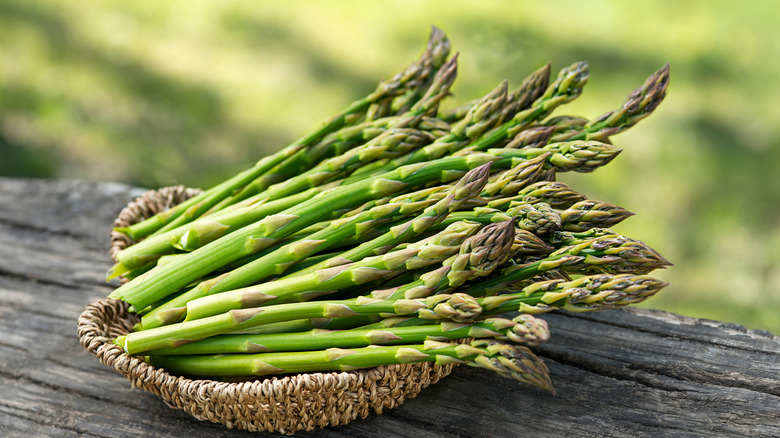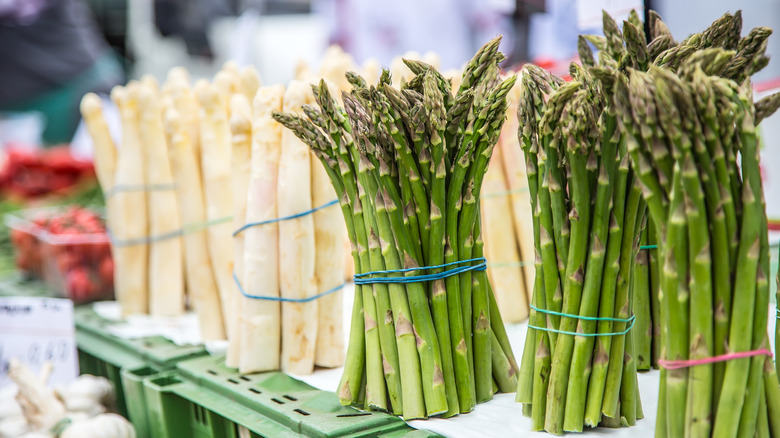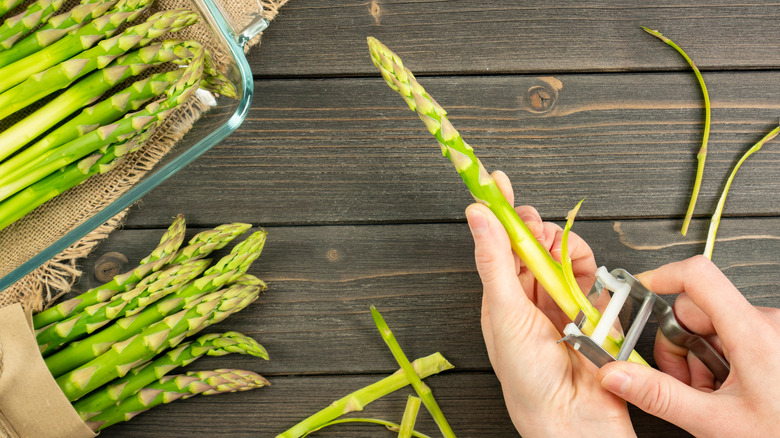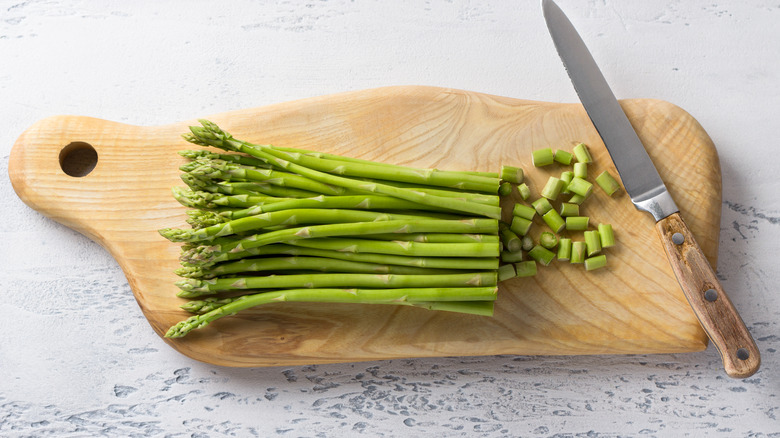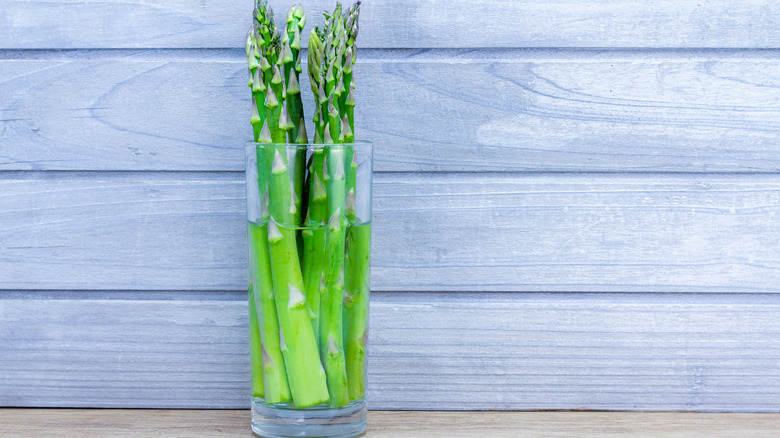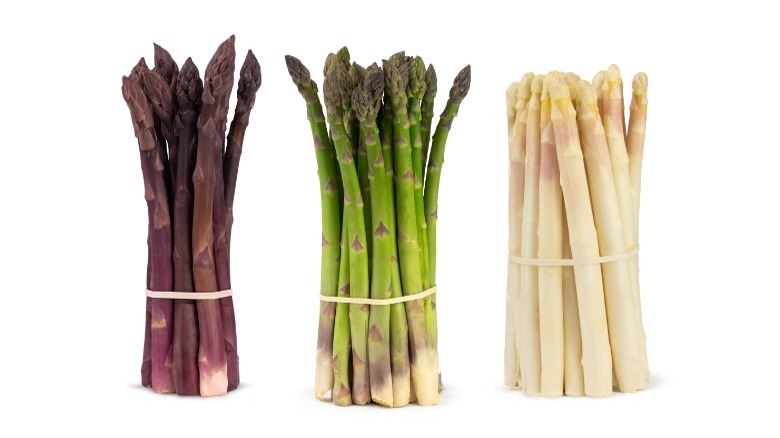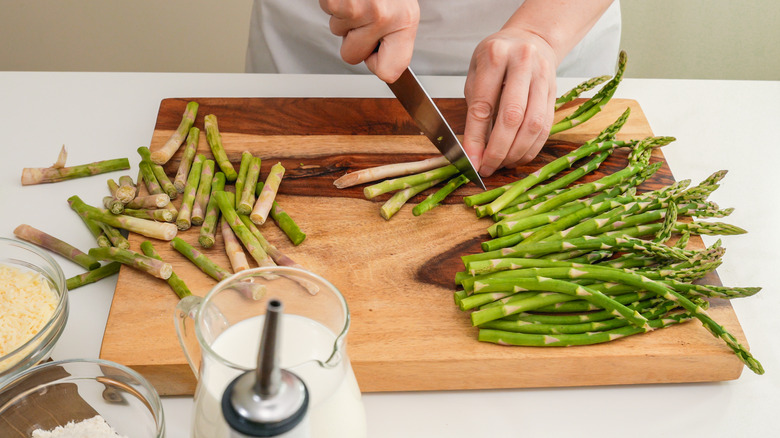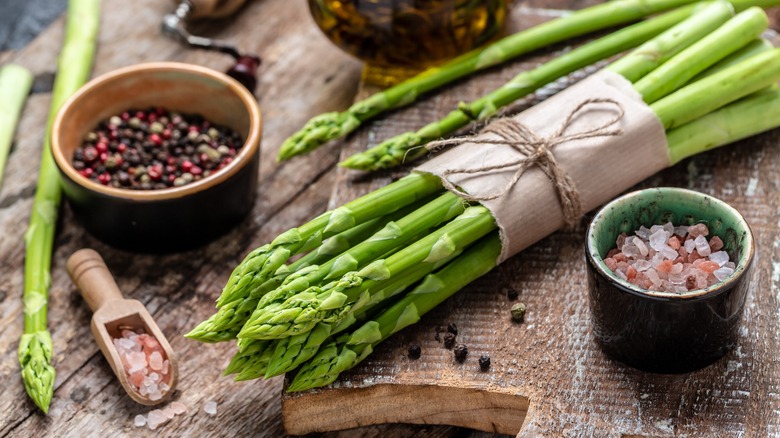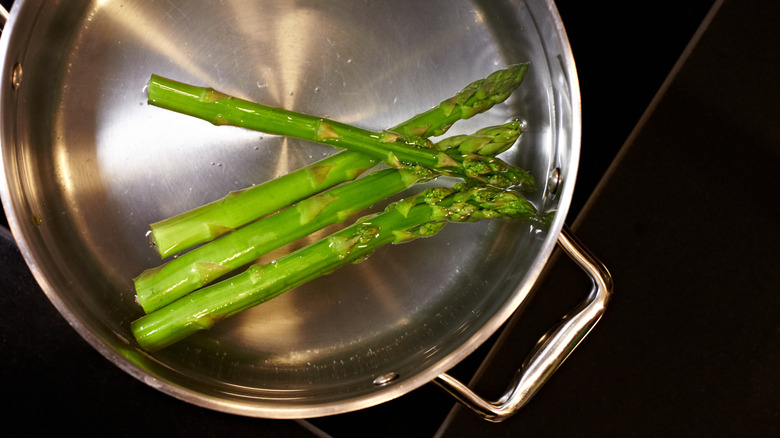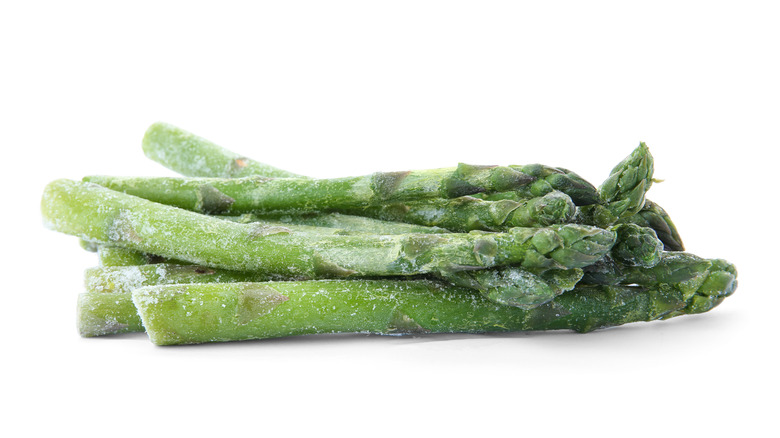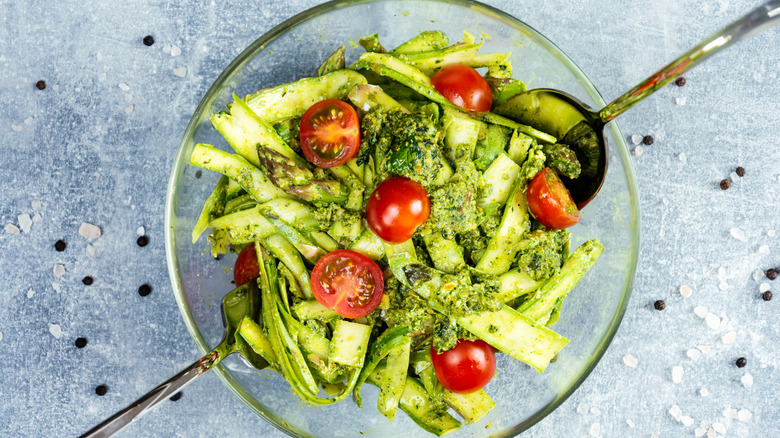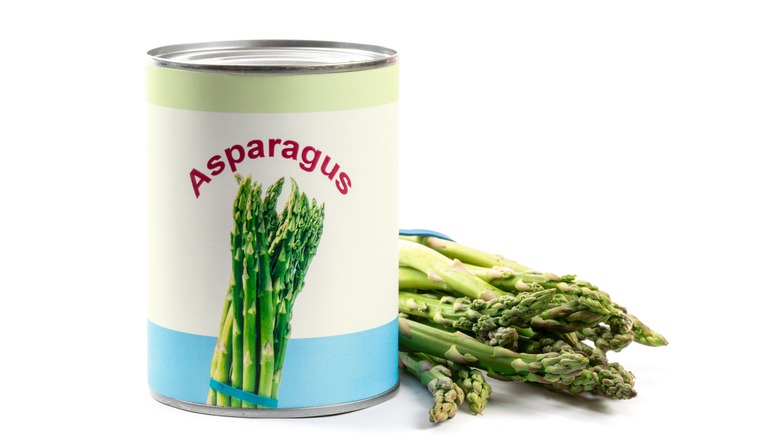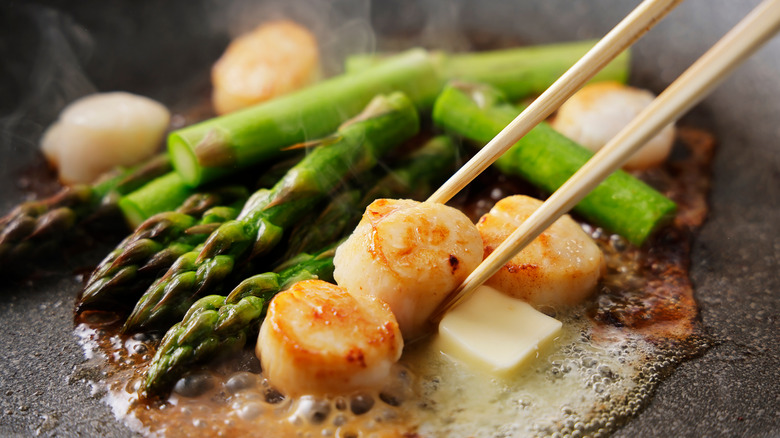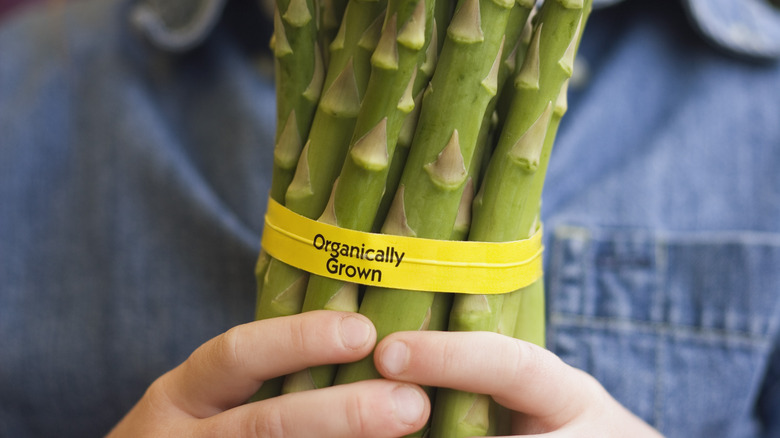14 Mistakes Everyone Seems To Make With Asparagus
When the long winter finally thaws and the weather warms up, we all start to crave those tender, crisp green vegetables that have eluded markets for months. Peas, fava beans, leeks, and green garlic are on our minds and on the menus of restaurants across the country, along with the king of spring produce — asparagus. This long green spear, a member of the lily family, is unique in the vegetable world in many respects. For one, each spear pokes out of the ground individually and connects to a crown-like root system. The spears can be harvested, and the roots will continue to shoot up spears repeatedly (for years, under the right conditions).
Although almost everyone is familiar with asparagus, there are tons of ways that people often mess up cooking it. Whether you prefer to roast, steam, sauté, or grill your asparagus, there are countless ways to incorporate this tasty vegetable into your cooking repertoire as long as you know all the best tips and tricks for avoiding common mistakes and avoiding unnecessary waste.
Buying it out of season
It can be easy to forget that asparagus has a growing season. After all, it can be found in the grocery store year-round. However, asparagus most definitely does have a growing season in North America. As soon as the weather begins to warm and the ground thaws, spears of asparagus start poking out of the ground, making it one of the most recognizable spring vegetables. In other parts of the year, asparagus is grown in other countries and shipped to the U.S., where it loses flavor and freshness.
For the best-tasting asparagus, buy spears in the spring. Not only will you find bunches with better flavor, but you will likely find a wider range of varieties, including the elusive purple and white varieties. In season asparagus is higher in vitamins and nutrients and is better for the environment, too, as it uses fewer fossil fuels to get between farm and table.
Not peeling it
Removing the woody end is one of the most fundamental steps when preparing asparagus. Some people bend the stalks until they snap, while others choose a point a few inches from the bottom and simply trim it off. While both of these methods work just fine, there is another method that is used by chefs all over the world. Peeling the green exterior of the bottom 2-3 inches of a spear of asparagus also works.
As it turns out, there's a pretty good reason you should start peeling asparagus instead of snapping it. A tip encouraged by gourmand and famous chef Julia Child, peeling asparagus towards the woody end makes it much more tender and allows you to consume much more of the spear. Once the tough exterior is peeled away, the interior is just as tender as the soft tips. However, make sure to peel before you blanch. If peeled after blanching, the asparagus will be too soft for the peeler.
Microwaving it
When you've had a long day at work, a familiar conundrum seems to pop up over and over again. All you want to do is relax, but you still have to prepare and make yourself dinner. Yes, you could always order out, but it just isn't sustainable in the long run. You stand at your refrigerator and ponder how long it will take you to cook the healthy and nutritious dinner you should be eating.
When looking to save some time, it can be tempting to try and cook asparagus in the microwave. Take our advice, and just don't. There are many things that can be prepared in the microwave to a similar degree of quality as one would expect from the stovetop or oven. Unfortunately, asparagus simply isn't one of them. If you want a simple, hands-off method for cooking this delicate vegetable, try roasting it in the air fryer or simply steaming it.
Tossing the ends
Don't toss those ends just yet! After trimming the ends off asparagus, most of us just toss them right in the garbage. After all, the ends tend to be woody and lacking flavor compared to the delicate tips. More and more, we're all looking to make the most of scraps and things we previously would toss without a moment's hesitation. Thankfully, there is a way to use every bit of the asparagus to make something new and delicious.
Using the ends to make soup is one of the best ways to use your leftover asparagus ends. Just because the ends are tough and fibrous doesn't mean they don't still contain flavor. By simmering them and blending the mixture, those fibers get broken down, and a final strain of the velvety soup removes the last unsavory bits. If you aren't into the idea of asparagus soup, you can always save them in your freezer for the next time you make vegetable stock.
Storing it dry
Unless you go grocery shopping every day, it's likely you have felt the familiar heartbreak of throwing away produce that went bad before you had a chance to cook it. Like all fresh vegetables, asparagus has a limited amount of time before it's destined for the garbage. In general, most vegetables prefer to be kept dry, and is one of the ways to keep asparagus fresh.
There's another way to store asparagus that helps them last even longer — ever thought that the bottom end of an asparagus spear looked just like the bottom of a cut flower stem? The two are remarkably similar, and just like flowers, asparagus lasts longer stood up on its ends soaking in water. The asparagus soaks up the water through the cut end, preventing it from getting limp and shriveled. There's no need to go crazy — about 1/2 inch of water should be plenty.
Ignoring the various varieties
If you think there is only one type of asparagus, think again. There are over 300 species of asparagus. Of course, some are more popular than others. The garden variety green type is by far and away the most common of all, and many subtypes fall into this category, such as Jersey Giant, Atlas, and Mary Washington. Each is slightly different, and some were cultivated to be resistant to certain environmental issues like disease or weather.
While the green types may dominate the market, there are many others to keep an eye out for. The two most common types you will find after green are white and purple. White asparagus is considered a delicacy in French cuisine and is technically the same as green asparagus but is grown in the dark to prevent the development of chlorophyll. Purple asparagus is a subtype that contains anthocyanins, which give it that gorgeous color.
Trimming off way too much
By now, you're already aware of the need to trim off the woody ends of asparagus. Not only are the ends dry where they were trimmed from the plant, but the bottom tends to be much more fibrous so it can support the weight of the stalk. Knowing precisely where the division is between woody and tender so you know where to trim the asparagus takes skill. Trimming too much of the asparagus wastes food unnecessarily.
Luckily, there is a tip for the best way to snap fresh asparagus at just the right point. Take a stalk in your hand and gently bend it until it snaps. As the theory goes, the stalk will snap at just the right spot where the fibrous texture ends. You can repeat this step with the other spears in your bunch or line up all the others against this one and cut at the same spot.
Not trimming off enough
We all want to avoid wasting precious pennies by not trimming off too much of the woody asparagus ends. The only problem with this is when we do not trim enough. Not only is the cut end of the asparagus usually a dried stump by the time you buy it, but the base of the spear is woody and fibrous and generally lacking in flavor. The plant grows this way so it can sustain the weight of the stalk as it grows upwards, but it also makes it very unpleasant to eat.
Even with the freshest in-season asparagus, you should be trimming at least an inch off the bottom. If you're worried about waste, you can put those trimmings to good use by making them into a soup or sauce. The ends really aren't good for eating due to the texture, so don't feel too guilty if you decide just to toss them in the end.
Skipping the blanch
Roasted, sautéed, grilled, fried; there are a ton of ways to cook asparagus. Whichever way you choose, you may be missing out on a crucial step. Blanching is a key step in cooking most green vegetables, and while it may seem intimidating, it is actually surprisingly easy. Start by bringing a pot of salted water to a boil and simmering the stalks for a few minutes before plunging them into ice water and drying them thoroughly.
Blanching keeps asparagus from drying out during the cooking process and is the main reason you should blanch asparagus before you grill it (or any other cooking method). Blanching also keeps asparagus from getting overcooked on the outside while the inside is still raw. Make sure to heavily salt the blanching water as well. Not only does this add flavor to the asparagus, but the salt actually helps draw the chlorophyll to the surface of the stalks, locking in the bright green color.
Freezing it raw
Yes, it is possible to freeze fresh asparagus, and not taking advantage of this time-saving hack could be yet another mistake you're making when cooking asparagus. In-season asparagus tastes much better than those flown in during the off-season, but what if you get a craving at other times of the year? These tasty green spears freeze surprisingly well, but there is one caveat that must be followed.
Asparagus clocks in at a whopping 93% water, which is just 3% less than lettuce (and you'd never even dream of freezing that delicate vegetable). All that water turns to ice crystals when frozen, which burst when you go to thaw the spears and lead to soggy, limp asparagus. By blanching asparagus before freezing, some of the texture (as well as the color) can be preserved. Don't thaw the asparagus before cooking with it, and stick with a hot-and-fast cooking method for best results.
Only eating it cooked
Of course, we all know that a perfectly blanched or sautéed spear of asparagus is a thing of beauty. If cooked correctly, the stalk is crisp-tender with just the right balance of softness and crunch. While cooked asparagus is definitely the most common way to eat this vegetable, raw asparagus is just as delicious and great in its own way.
Many people don't know that asparagus can be eaten raw, which is best prepared by shaving the stalks using a sharp knife or peeler. Toss the shaved raw asparagus into a salad, where the vinaigrette will help soften the vegetable to an edible consistency. If this method piques your interest, you'll want to seek out good quality in-season asparagus. Otherwise, you may find that your raw asparagus is seriously lacking in flavor. This is also the best way to prepare purple asparagus, which loses that gorgeous hue when heated.
Buying it canned
Canned vegetables can be tempting to buy over raw vegetables for a few reasons. They're cheap, accessible, and at least partially cooked already. While some canned vegetables are worth getting, asparagus is one of those that should be a hard pass. In general, canned asparagus tends to have a softer, mushier texture than fresh asparagus. This is due to longer cooking periods during the canning process to ensure that everything is fully sterilized. This process also affects the flavor, both from the cooking/canning process and the taste of the can itself, as well as the nutritional value.
In addition to these problems, canned asparagus comes loaded with sodium. In all, if you can avoid getting canned asparagus at all costs, do it. If fresh asparagus is too expensive, you may have to wait for it to come back in season when the abundance makes the prices drop.
Cooking it bland
When there are so many delicious and inventive recipes calling for asparagus, it could be considered a mortal sin to prepare them blandly. There are great recipes to suit any kind of cooking ability or time constraint, from simple roasted asparagus to complex dishes with ingredients like soft-boiled egg and chorizo. For a simple side, asparagus cooks great in a hot cast iron pan, just as it does when tossed on the grill dressed in a little olive oil and salt.
Culinary pros might be interested in something a bit more interesting, like an asparagus tart with goat cheese and layers of flaky and delicate puff pastry. The classic French vichyssoise can be made green with the addition of green asparagus for an elegant and light meal to enjoy on warm spring days. Of course, asparagus also works well as a background note in other dishes like risotto, pasta, and creamy cauliflower rice.
Not taking off the rubber band
Picture this: You have just arrived home from the market with your gorgeous bunch of fresh asparagus. You place it in the refrigerator until you're ready to cook it, leaving the rubber band around the spears. After all, the market sold it that way to keep all the stalks bundled together, so why shouldn't you do the same? Turns out, there is one thing you should do with a fresh bunch of asparagus the second you get home.
Leaving the rubber band on the spears can bruise the tender vegetable, leading to a limp and soggy texture. Also, keeping them tightly bound doesn't allow the stalks to breathe, which can cause them to spoil faster. If you want a simple way to keep your asparagus tidy without causing damage, try storing them upright in a glass jar — just don't forget to add a bit of water!
